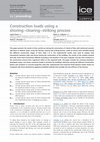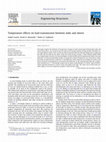RIC Vol 31 Nº2, Agosto 2016 by I. Gasch

El objetivo del presente trabajo es definir diferentes alternativas de procesos constructivos, es... more El objetivo del presente trabajo es definir diferentes alternativas de procesos constructivos, estimando cuáles resultan ser las más beneficiosas respecto a su plazo de ejecución y su coste, para un edificio de forjados de losa maciza de hormigón armado. Para resolver los plazos de ejecución se plantearon tres alternativas del proceso constructivo: Cimbrado y Descimbrado; Cimbrado, Clareado y Descimbrado; y Cimbrado, Recimbrado y Descimbrado, considerado 2, 3 y 4 plantas consecutivas apuntaladas. Para evaluar qué procesos son válidos, primero se calculan las cargas que se presentan durante el proceso constructivo mediante el Nuevo Procedimiento Simplificado y posteriormente se comprueba si se cumple o no, en cada una de las operaciones constructivas, la condición de descimbrado. Para el edificio objeto de estudio se han obtenido como procesos viables económica y técnicamente los procesos constructivos de Cimbrado, Clareado y Descimbrado con 3 y 4 plantas cimbradas.
The aim of this paper is to define alternative construction processes for a building with reinfor... more The aim of this paper is to define alternative construction processes for a building with reinforced concrete slab floors, thereby estimating which ones are most beneficial in terms of their execution time and cost. Three alternatives were proposed to solve the deadlines of the construction process: Shoring and Striking; Shoring, Clearing and Striking; and Shoring, Reshoring and Striking, considering 2, 3 and 4 consecutive shored floors. In order to evaluate what processes are valid, first it is necessary to calculate the loads during the construction process using the New Simplified Procedure and subsequently check whether or not the striking condition is fulfilled in each of the construction operations. Regarding the studied building, the feasible construction processes were: Shoring, Clearing and Striking with 3 and 4 consecutive shored floors.
Papers by I. Gasch
Informes de la Construcción, 2016
de la construcción informes Volumen 65 Nº 530 abril-junio 2013 Madrid (España)

Proceedings of the ICE - Structures and Buildings, 2014
This paper presents the results of tests carried out during the construction of a block of flats ... more This paper presents the results of tests carried out during the construction of a block of flats with reinforced concrete slab floors in Madrid, Spain, using the shoring, clearing and striking process. Loads on shores were recorded during the different construction stages of floor slabs 1 to 6. The experimental results were used to analyse load transmission between slabs and shores during the construction of the building. The results of the analysis showed that slab-shore load transmission differed according to the position of the span analysed, and also that variations in the construction process had a significant effect on the expected loads. The paper includes the evolving calculation developed using a non-linear numerical model to simulate the building's behaviour during the different construction phases and variations in concrete properties with time. Experimental and numerical finite-element model results are compared with those obtained by applying simplified methods that consider the real stiffness of the shoring.

Engineering Structures, 2010
This paper contains a summary and evaluation of an experimental research project carried out at t... more This paper contains a summary and evaluation of an experimental research project carried out at the ICITECH laboratories, Valencia, Spain. The project consisted of the construction of a full-scale building that included a process of shoring, clearing and striking (SCS). The experimental model was used as the basis for the development of a FE model, including an evolving calculation, with the objective of simulating the construction process used, as well as studying the evolution of concrete properties during the test. The FE model was verified with the results obtained from the experimental model. Two further FE models were then developed from the original model and used to simulate the construction of the same building using two different construction processes: one involving shoring and striking (SS) and the other shoring, reshoring and striking (SRS). Finally, the SCS was compared to the SS and SRS processes, respectively, and an analysis was made of the advantages and disadvantages of each one. The paper breaks new ground in that for the first time ever a comparative study is made of the three most frequently used shoring techniques.

Engineering Structures, 2012
This paper analyses the influence of temperature changes on load transmission between floor slabs... more This paper analyses the influence of temperature changes on load transmission between floor slabs and shores during the in situ casting of concrete slabs by the shoring-clearing-striking method. Therefore several experimental studies were carried out which measured both the internal temperature evolution of the slabs and the loads on the shores. With the results of these studies, a Finite Element Model (FEM) of an experimental structure was then developed. In both the FEM and the experimental studies the same behaviour was observed regarding changes in temperature. When temperatures rose, the loads on shores decreased, accompanied by a reduction in slab deflection. When temperatures dropped, the loads on the shores increased, accompanied by an increased slab deflection. In the experimental study, for a temperature increment of ±1°C the load per surface unit on shores varied between 0.13 kN/m 2 and 0.34 kN/m 2 , which represents between 2% and 6% of the self-weight of the slabs. The main cause of these load variations appears to be the temperature gradient inside the floor slabs.









Uploads
RIC Vol 31 Nº2, Agosto 2016 by I. Gasch
Papers by I. Gasch